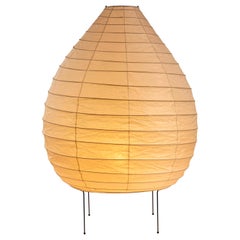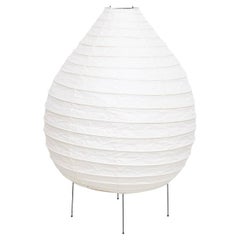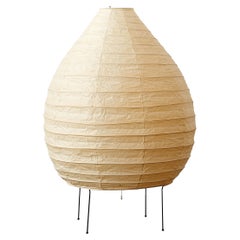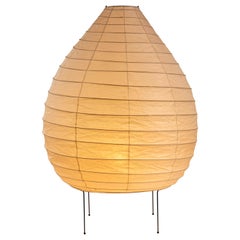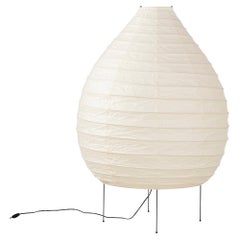Akari 23n
21st Century and Contemporary Japanese Mid-Century Modern Floor Lamps
Metal
1990s Japanese Mid-Century Modern Floor Lamps
Metal
Mid-20th Century Japanese Mid-Century Modern Floor Lamps
Bamboo, Paper
Recent Sales
21st Century and Contemporary Japanese Mid-Century Modern Floor Lamps
Metal
2010s Japanese Mid-Century Modern Floor Lamps
Metal
People Also Browsed
Early 2000s Philippine Mid-Century Modern Wall Lights and Sconces
Rattan
Vintage 1970s Italian Mid-Century Modern Benches
Wood
Vintage 1930s Swedish Art Deco Side Tables
Birch, Elm
21st Century and Contemporary French Andirons
Bronze
20th Century Brazilian Organic Modern Loveseats
Hardwood
Vintage 1970s Italian Mid-Century Modern Sofas
Upholstery
Vintage 1950s European Egyptian Revival Stools
Wood
Antique 1820s English George III Settees
Brass
Vintage 1970s Swiss Mid-Century Modern Daybeds
Leather, Wood
Mid-20th Century French Settees
Cane, Rosewood
Antique 1750s Chinese Qing Cabinets
Walnut, Lacquer
1990s American Mid-Century Modern Club Chairs
Leather, Rattan
Vintage 1950s Finnish Mid-Century Modern Sofas
Brass
Vintage 1970s French Mid-Century Modern Chandeliers and Pendants
Brass
2010s Italian Other Console Tables
Wood
Early 20th Century French Art Deco Loveseats
Velvet, Wood
Isamu Noguchi for sale on 1stDibs
A sculptor, painter, ceramicist and furniture and lighting designer, Isamu Noguchi was one of the most prolific and protean creative forces of the 20th century and a key figure in the development of organic modernism. Noguchi’s sculptures and designs — his chairs and tables as well as his timeless Akari lamp and other lighting fixtures — share a common spirit: one of lyrical abstraction, tempo and flow and harmonious balance.
Noguchi was born in Los Angeles to an American mother and Japanese father, and spent most of his childhood in Japan. He returned to the United States at age 13, went to high school in Indiana and enrolled at Columbia University to study medicine. At the same time, he took night courses in sculpture.
Within three months, Noguchi left college to pursue art full time. Noguchi was awarded a Guggenheim Fellowship in 1927 and traveled to Paris to work under Constantin Brancusi. It marked a turning point. Inspired by Brancusi, Noguchi embraced abstraction and began to sculpt in the expressive, rhythmic style that would be the hallmark of his work.
Once back in New York, Noguchi was introduced to design by what would become a lifelong collaboration creating sets for choreographer Martha Graham. His first industrial designs were in Bakelite: the sleek Measured Time kitchen timer created circa 1932, and his famed Zenith Radio Nurse intercom, from 1937.
Ten years later, Herman Miller introduced Noguchi’s now-iconic glass-topped coffee table with an articulated wooden base. His washi paper and bamboo Akari light sculptures, handmade in Japan, debuted in 1951. In the late 1950s, Noguchi designed for Knoll, creating such pieces as his dynamic Cyclone table and rocking stool.
For collectors, Noguchi’s furniture and lighting designs remain his most accessible work — they have the same power and presence that Noguchi brought to his art.
Find vintage Isamu Noguchi floor lamps, table lamps, coffee tables and other furniture on 1stDibs.
A Close Look at Mid-century-modern Furniture
Organically shaped, clean-lined and elegantly simple are three terms that well describe vintage mid-century modern furniture. The style, which emerged primarily in the years following World War II, is characterized by pieces that were conceived and made in an energetic, optimistic spirit by creators who believed that good design was an essential part of good living.
ORIGINS OF MID-CENTURY MODERN FURNITURE DESIGN
- Emerged during the mid-20th century
- Informed by European modernism, Bauhaus, International style, Scandinavian modernism and Frank Lloyd Wright’s architecture
- A heyday of innovation in postwar America
- Experimentation with new ideas, new materials and new forms flourished in Scandinavia, Italy, the former Czechoslovakia and elsewhere in Europe
CHARACTERISTICS OF MID-CENTURY MODERN FURNITURE DESIGN
- Simplicity, organic forms, clean lines
- A blend of neutral and bold Pop art colors
- Use of natural and man-made materials — alluring woods such as teak, rosewood and oak; steel, fiberglass and molded plywood
- Light-filled spaces with colorful upholstery
- Glass walls and an emphasis on the outdoors
- Promotion of functionality
MID-CENTURY MODERN FURNITURE DESIGNERS TO KNOW
- Charles and Ray Eames
- Eero Saarinen
- Milo Baughman
- Florence Knoll
- Harry Bertoia
- Isamu Noguchi
- George Nelson
- Danish modernists Hans Wegner and Arne Jacobsen, whose emphasis on natural materials and craftsmanship influenced American designers and vice versa
ICONIC MID-CENTURY MODERN FURNITURE DESIGNS
- Eames lounge chair
- Nelson daybed
- Florence Knoll sofa
- Egg chair
- Womb chair
- Noguchi coffee table
- Barcelona chair
VINTAGE MID-CENTURY MODERN FURNITURE ON 1STDIBS
The mid-century modern era saw leagues of postwar American architects and designers animated by new ideas and new technology. The lean, functionalist International-style architecture of Le Corbusier and Bauhaus eminences Ludwig Mies van der Rohe and Walter Gropius had been promoted in the United States during the 1930s by Philip Johnson and others. New building techniques, such as “post-and-beam” construction, allowed the International-style schemes to be realized on a small scale in open-plan houses with long walls of glass.
Materials developed for wartime use became available for domestic goods and were incorporated into mid-century modern furniture designs. Charles and Ray Eames and Eero Saarinen, who had experimented extensively with molded plywood, eagerly embraced fiberglass for pieces such as the La Chaise and the Womb chair, respectively.
Architect, writer and designer George Nelson created with his team shades for the Bubble lamp using a new translucent polymer skin and, as design director at Herman Miller, recruited the Eameses, Alexander Girard and others for projects at the legendary Michigan furniture manufacturer.
Harry Bertoia and Isamu Noguchi devised chairs and tables built of wire mesh and wire struts. Materials were repurposed too: The Danish-born designer Jens Risom created a line of chairs using surplus parachute straps for webbed seats and backrests.
The Risom lounge chair was among the first pieces of furniture commissioned and produced by celebrated manufacturer Knoll, a chief influencer in the rise of modern design in the United States, thanks to the work of Florence Knoll, the pioneering architect and designer who made the firm a leader in its field. The seating that Knoll created for office spaces — as well as pieces designed by Florence initially for commercial clients — soon became desirable for the home.
As the demand for casual, uncluttered furnishings grew, more mid-century furniture designers caught the spirit.
Classically oriented creators such as Edward Wormley, house designer for Dunbar Inc., offered such pieces as the sinuous Listen to Me chaise; the British expatriate T.H. Robsjohn-Gibbings switched gears, creating items such as the tiered, biomorphic Mesa table. There were Young Turks such as Paul McCobb, who designed holistic groups of sleek, blond wood furniture, and Milo Baughman, who espoused a West Coast aesthetic in minimalist teak dining tables and lushly upholstered chairs and sofas with angular steel frames.
Generations turn over, and mid-century modern remains arguably the most popular style going. As the collection of vintage mid-century modern chairs, dressers, coffee tables and other furniture for the living room, dining room, bedroom and elsewhere on 1stDibs demonstrates, this period saw one of the most delightful and dramatic flowerings of creativity in design history.
Finding the Right Floor-lamps for You
The modern floor lamp is an evolution of torchères — tall floor candelabras that originated in France as a revolutionary development in lighting homes toward the end of the 17th century. Owing to the advent of electricity and the introduction of new materials as a part of lighting design, floor lamps have taken on new forms and configurations over the years.
In the early 1920s, Art Deco lighting artisans worked with dark woods and modern metals, introducing unique designs that still inspire the look of modern floor lamps developed by contemporary firms such as Luxxu.
Popular mid-century floor lamps include everything from the enchanting fixtures by the Italian lighting artisans at Stilnovo to the distinctly functional Grasshopper floor lamp created by Scandinavian design pioneer Greta Magnusson-Grossman to the Paracarro floor lamp by the Venetian master glass workers at Mazzega. Among the more celebrated names in mid-century lighting design are Milanese innovators Achille and Pier Giacomo Castiglioni, who, along with their eldest brother, Livio, worked for their own firm as architects and designers. While Livio departed the practice in 1952, Achille and Pier Giacomo would go on to design the Arco floor lamp, the Toio floor lamp and more for legendary lighting brands such as FLOS.
Today’s upscale interiors frequently integrate the otherworldly custom lighting solutions created by a wealth of contemporary firms and designers such as Spain’s Masquespacio, whose Wink floor lamps integrate gold as well as fabric fringes.
Visual artists and industrial designers have a penchant for floor lamps, possibly because they’re so often a clever marriage of design and the functions of lighting. A good floor lamp can change the mood of any room while adding a touch of elegance to your entire space. Find yours now on 1stDibs.
